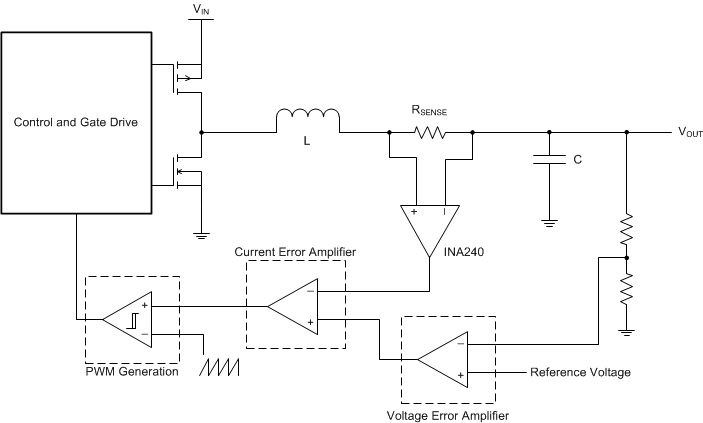SLYT710B september 2017 – august 2023 LM22670 , LM25145 , LM2696 , LM3100 , LM3150 , LM3475 , LM3485 , LM5017 , LM5116 , LM5119 , LM5140-Q1 , LM5145 , TPS40040 , TPS40057 , TPS40170 , TPS51116 , TPS53014 , TPS53219A , TPS53355 , TPS54325 , TPS54336A , TPS543B20 , TPS543C20 , TPS543C20A , TPS54478 , TPS54610 , TPS54620 , TPS548A20 , TPS548D22 , TPS54A20 , TPS56121 , TPS56C215 , TPS62097 , TPS62130 , TPS82130
- 1
- 1 Overview
- 2 Voltage mode
- 3 Voltage mode with voltage feed-forward
- 4 Peak current mode
- 5 Average current mode
- 6 Emulated current mode
- 7 Internally-compensated advanced current mode (ACM)
- 8 Hysteretic control mode
- 9 Constant on-time
- 10Constant on-time with emulated ripple mode
- 11DCS-Control™: Direct control with seamless transition into power-save mode
- 12Direct connection to the output capacitor (D-CAP™)
- 13D-CAP+™
- 14D-CAP2™
- 15D-CAP3™
- 16D-CAP4™
5 Average current mode
Average current mode addresses noise immunity issues, peak-to-average current errors, and slope compensation needs of peak current mode. Average current mode introduces a high gain integrating current error amplifier into the current loop. The voltage across a current sense resistor represents the actual inductor current. The difference, or current error, is amplified and compared to a large amplitude saw-tooth (oscillator ramp) at the PWM comparator inputs. The gain of the current loop effectively sets the slope compensation without restricting the minimum on-time or minimum-off time. Current sensing is usually inside the regulator, but can be external.
When to use: Effectively control currents other than inductor current, allowing a much broader range of topological application.
Popular devices: TPS546D24S, TPS546B24S
Learn more: Average Current Mode Control of Switching Power Supplies
